
A goal without a plan is only a dream
Brian Tracy
Goals have always been an indispensable part of human life and as we keep advancing in life, we keep setting new goals for ourselves. As individuals, we pursue a wide range of goals simultaneously. Similarly, if we look at it in the context of organizations, they have their strategic goals that are linked to revenue generation, brand awareness, solving a social problem, and so on. The world will be so directionless and purposeless without goals, isn’t it?
Table of Contents
However, setting goals and achieving them are two entirely different things. One can easily say that the world has more people who have failed in their goals rather than those who achieved them. What do you think is the underlying difference between those who accomplish their goals and those who see the opportunities passing by?
The major difference lies in how people set their goals and plan their goals. Ultimately, it is the effectiveness of how goals are planned that determines the chances of success. In other words, your goal setting has to be smart enough to drive high prospects of achievement. Have you heard about SMART Goal yet?
In this article, we shed light on everything you need to know about SMART Goals' meaning, its template, and its various examples. Besides, there is a step-by-step explanation of how you can write SMART Goals to enhance your journey of achievements. So, let us get started without much ado.
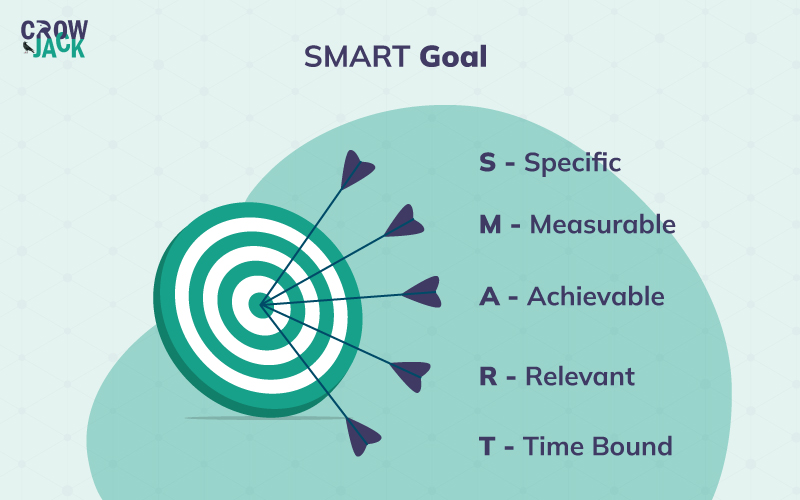
What are SMART Goals?
Different individuals or organizations have different approaches to setting goals and pursuing them to reach the expected outcomes. Among these goal-setting strategies, the concept of SMART Goals is quite popular and is extensively used at all levels. In fact, it would not be incorrect to say that the SMART approach is the smarter way of setting and achieving goals. If you have big dreams that you wish to translate into reality, SMART goals may be all that you need.
To elaborate, SMART is an acronym that stands for:
- Specific
- Measurable
- Achievable
- Relevant
- Time-bound
If we talk about the SMART Goals definition, these are goals that have immense clarity in terms of what they wish to achieve and have great scope for measuring progress and milestones. To add, SMART goals are also highly effective in terms of offering insights on which actions are needed for a goal to be met and the metrics that can be used to gauge the actions. Using the SMART approach to goal setting, you can both set your goals and evaluate them in an efficient manner to drive the best results. In fact, many people find apps to improve yourself helpful for tracking and managing these SMART goals on a daily basis.
But the question here is, how exactly is a SMART goal different from a usual goal? Are there any parameters that a goal must meet to qualify as a SMART goal? The subsequent section will answer all these engaging questions.
SMART Goals Criteria
The criteria for goals to be identified as SMART goals are quite extensive in their own way. For a goal to be SMART, it must be aligned with the framework on which SMART goals are based. To explain in detail, a goal should have the following features or traits to qualify the criteria for being a SMART goal.
For a goal to be SMART, it must be:
- Specific: According to Rocket Ranker, SMART goals have a high degree of specificity and clarity in terms of what they wish to accomplish. There should be no misconceptions at all or any room for misunderstanding. To add, these goals are directed to a narrow context as that would enable more effective planning and execution.
- Measurable: For a goal to qualify as a SMART goal, it must define the metrics and milestones that can be used to measure it. The scope for measurement of progress in terms of goals makes them trackable. Further, as long as you can track your goals, you will always know if your current performance is aligned with your goals or not.
- Achievable: This trait of SMART goals focuses on the significance of a goal and the prerequisite skills or tools needed to make the goal achievable. To elaborate, this feature explains the course of action that is needed to attain the goal successfully.
- Relevant: Relevance is another imperative quality of SMART goals. Every SMART goal is aligned to some values, visions, future strategies, or wider goals that are essential for an individual or organization. In simpler words, your goal will qualify as a SMART goal only when it has a great degree of relevance to a larger goal or strategic plan you may have.
- Time-bound: As the name of the feature explains, SMART goals have designated deadlines that are realistic and rational. There is a well-defined time frame in which a goal and its milestones are to be achieved.
Having understood the above criteria in depth, now it is lucid how SMART goals work. Moving forward, the ensuing section provides a stepwise breakdown of the process that you need to undertake to write SMART goals. But before we move to that, do you realize how important it is to write down your goals?
You will be amused to know that people who are in the habit of writing down their goals are 20 percent more likely to accomplish them successfully. Such amazing insights on goal setting clearly explain how a simple act of writing down goals can optimize the chances of your success. Having said that, let us get started with writing SMART goals.
How to write SMART Goals?
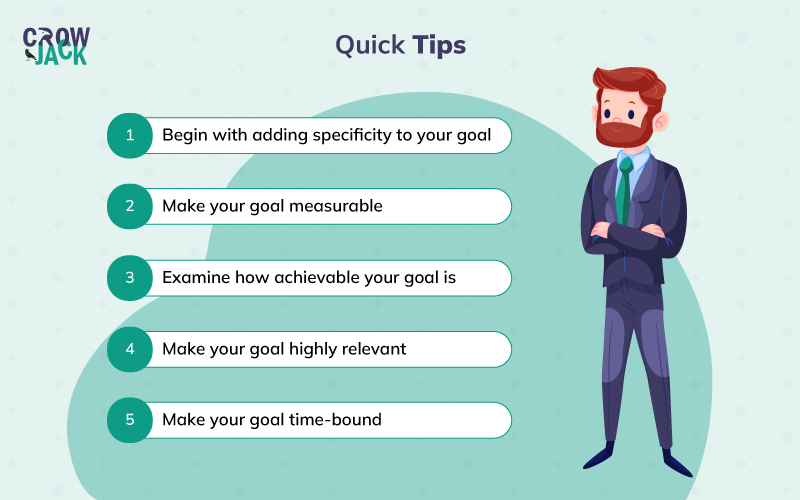
1. Begin with adding specificity to your goal
The first and foremost step in writing a SMART goal is to clearly and precisely define your goal with a high degree of specificity. You ought to have complete clarity on the end result you desire upon achieving your goal. This is for the simple reason that when your goal is specific, you will have a clear sense of direction as to how you want to approach your goal. On the other hand, when your goal lacks the prerequisite clarity, it will lead to misconceptions and a lack of direction.
But how are you exactly going to make your goal specific? What are the criteria that will add specificity to your goals? This is where you need to answer a few questions when you begin to write down your goal. The key ‘w’ questions that you should be answering are listed below.
- Who: This is the basic question you need to ask yourself or a team needs to ask while writing a SMART goal. It needs to be clearly defined who is concerned with the goal and who all need to be involved in order to accomplish the goal. For instance, if the top management of an organization is working on a change management strategy, the change leaders have to be clearly defined.
- What: This is in fact, the most important question you should be effectively answering when you write down a goal. There needs to be a clear understanding of what the goal actually is and what are the end results that the goal is aiming at.
- When: Things are more specific when they have a well-thought time frame in which they have to be done. The same applies to goals and having said that defining the time frame is an essential component of a SMART goal.
- Where: In case your goal is dependent on any location or specific places that are a part of the entire process, they need to be specified beforehand. So, wherever applicable, you should answer this question precisely while writing your goals.
- Which: This question aims to identify if there are any hurdles or challenges that you need to navigate in the pursuit of your goal. Hence, if there are any specific challenges or obstacles that directly impact the successful achievement of your goals, they need to be taken into account.
- Why: This question gauges the importance of your goal in terms of why is your goal relevant and why it needs to be accomplished as per the chosen time frame.
Once you have answered all these questions in a realistic, decisive, and effective manner, you can then give your goal a specific outlook inspiring worthwhile strategies.
Key tip: If you are working in a team and the goal being written involves every team member, ask your team members to individually answer the above questions. This will ensure that everyone is on the same page and differences in opinions are accounted for. You can then write your goal with greater specificity.
2. Make your goal measurable
The next step to drafting a SMART goal is to make your goal quantifiable and measurable so that its progress and achievement can be tracked. Of course, there has to be a set benchmark in terms of a quantifiable value that will explain the achievement of a goal. If there is no benchmark, how will you determine if your goal is accomplished or not?
Hence, to make your goal measurable and trackable, you need to designate relevant milestones and key performance indicators. These key performance indicators or metrics will help you in keeping a constant track of the progress you make in the direction of achieving your goal.
In fact, it is always a good approach to break a big goal into small milestones and apply metrics to them. Doing so makes your goal-setting more systematic and then you can approach it with one milestone in mind at a time. For instance, as a business leader, you can associate key performance indicators for measuring the progress of your strategic plans.
3. Examine how achievable your goal is
In this step that corresponds to the achievable trait of a goal, you need to determine how attainable a goal is. Furthermore, you need to ascertain if you or your organization will require any special skills or tools to achieve the goal under consideration. In case a team or organization lacks the prerequisite skills, it needs to be figured out how those skills can be attained.
To elaborate, this is where you need to create a roadmap for your goal with a clear understanding of how you can accomplish your goal and what actions need to be taken. Unless you know everything about what you will require to accomplish your goal, the execution and actionability will not be as effective as needed. For instance, you can use the Pareto Principle for better time management in terms of accomplishing your goals.
So, when you are writing your SMART goal, you should clearly list down the factors or requirements that are needed to achieve the goal.
Key tip: In a rough draft, list down all the tools, skills, and other requirements needed to meet the goal in one column. In another column, write down the skills and tools that you or your team already have. In this way, you can quickly figure out what you need to attain to achieve the goal. Subsequently, you can write this section of your goal in a more efficient way.
4. Make your goal highly relevant
When you are writing your goal, you need to ensure that it is relevant to broader objectives or a future vision. In other words, your goal should serve a larger purpose upon its accomplishment. Having said that, you have to align your goal to a set of values, strategic plans for the future, or goals that aim to achieve broader results. Also, you need to define its relevance with respect to the current scenario.
For instance, if the HR department of an organization has a goal to boost boost employee engagement levels, it should be aligned with the overall business strategy of the organization keeping profitability in mind. If it is not in alignment with the overall success of the company, it would rather be irrelevant.
Key tip: To determine the relevance of your goal, you should question what is going to change after your goal is accomplished and how it can be a headstart for bigger goals. Being inquisitive will certainly help here.
5. Make your goal time-bound
This is the last and perhaps the easiest step in writing your SMART goals. When you write a goal, you need to designate a realistic deadline for the completion of your goal. The time frame will have a crucial role to play in how you or your team will plan and work upon the actions needed to successfully achieve the goal.
Key tip: Always check your deadlines for relevance. It should not happen that you set unrealistic deadlines that discourage the entire team or do not account for the skills or tools that need to be acquired for the accomplishment of the goal.
Now that you know how to write a SMART goal, it is equally important to learn about the template in which you have to present your goal. The next section presents the template that you need to follow while writing your SMART goals.
SMART Goals Template
There is a systematic framework that you need to follow while writing your SMART goals. The SMART Goal template is easy to use and helps you plan and write your goal in a way that you know the SMART objectives clearly and can track your progress effectively. To add, your goal becomes far more actionable when you write it as per the SMART goal template. The template is presented below.
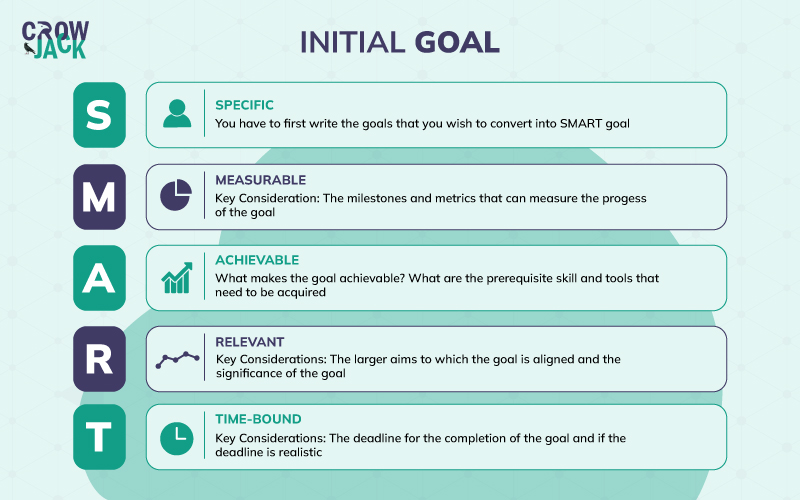
It is noteworthy that when you write your goal as per the above template of SMART goals, the information needs to be concise and to the point.
For an ever clearer understanding of how SMART goals are set and planned, let us check out some examples that take different scenarios into consideration.
SMART Goals Examples
We have taken four different examples, we cover SMART goals examples for work, in healthcare, for students, and for a manager. These examples cover different purposes and domains of life with respect to goal setting. Therefore, let’s get going!
Example 1: Example of SMART goal for a student

Example 2: Example of SMART goal in healthcare

Example 3: Example of SMART goal for a manager
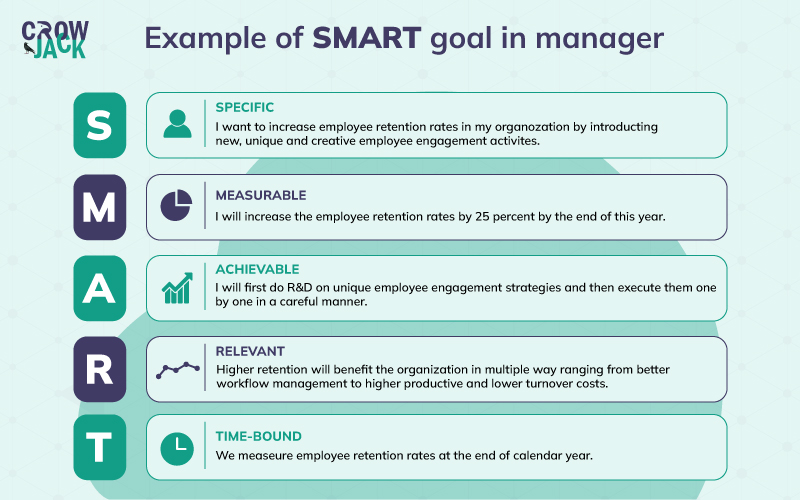
Example 4: Example of SMART goal for a project manager
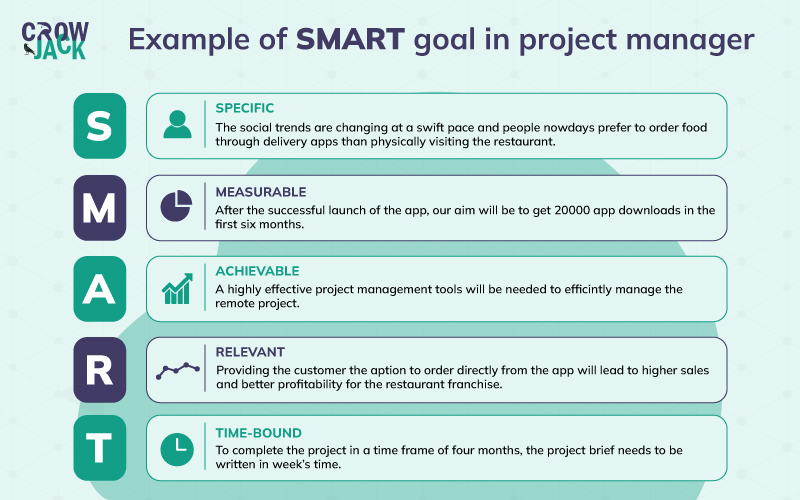
FAQs
What are the limitations of SMART Goals?
Although SMART Goals can help you achieve success and add clarity to your life. However, there are also potential limitations of SMART goals such as a lack of flexibility, narrow focus, and rigidity in the plan.
When do SMART Goals fail?
SMART goals do not assure that everything will go 100% correct all the time. As mistakes will take place and if you think everything will go according to the plan, that's when SMART goals fail.

 Proof Reading
Proof Reading  Copy Writing
Copy Writing  Resume Writing
Resume Writing  Blogs
Blogs Guides
Guides SOP's
SOP's Student Resources
Student Resources Research Topics
Research Topics Login
Login Register
Register